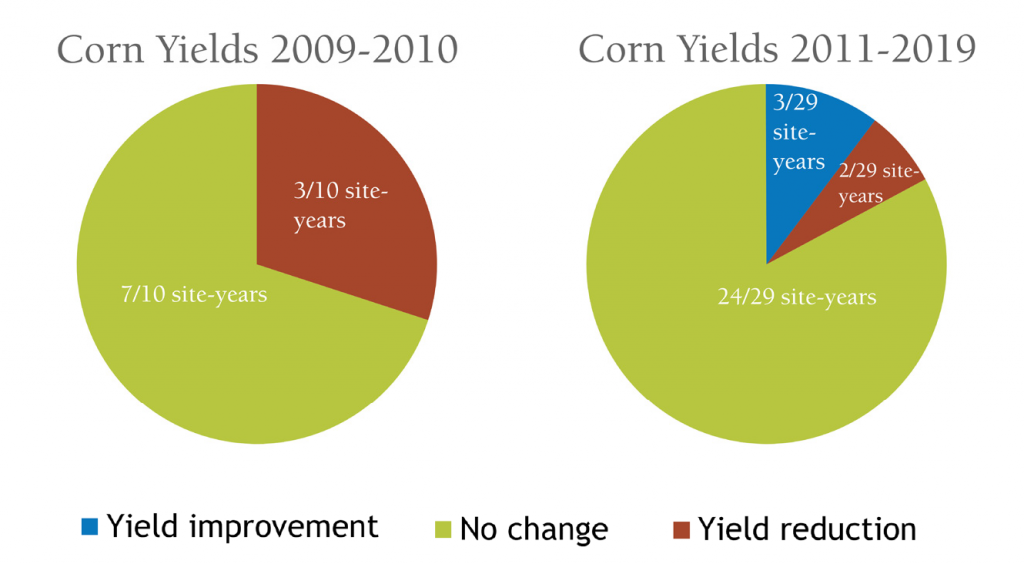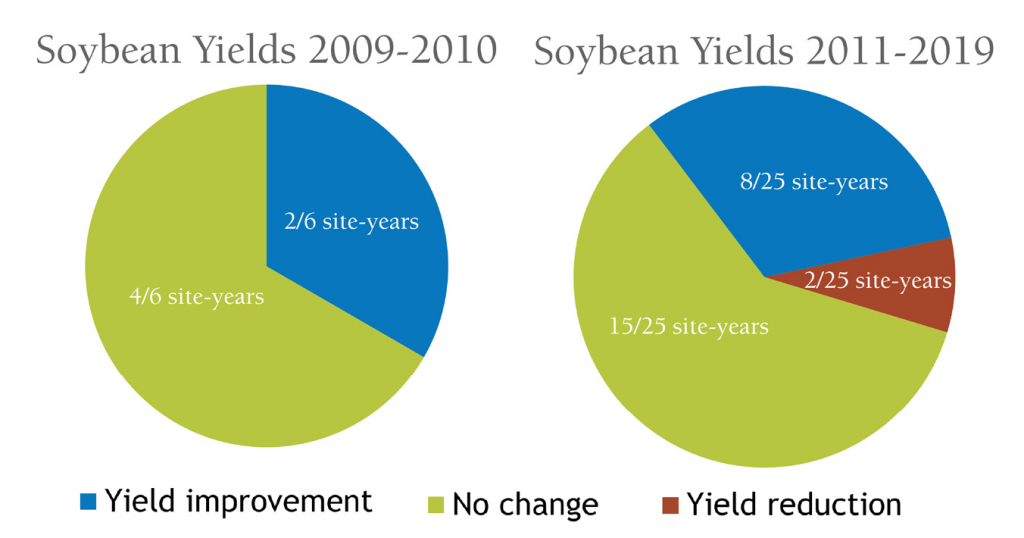This is a joint project between Practical Farmers of Iowa and Iowa Learning Farms.
Summary
Farmers reported that in 63 of 70 site-years, properly managed cover crops had little to no negative effect on corn and soybean yield (and actually increased soybean yield in 10 site years and corn yield in 3 site-years).
Project Timeline
2008-2019 (final report) This project was funded by the State Soil Conservation Committee, the Iowa Department of Agriculture and Land Stewardship and the Leopold Center for Sustainable Agricultre. Additional outreach and education funding came from a NCR-SARE grant, Walton Family Foundation, Iowa Learning Farms, Iowa State University Extension and Outreach and Practical Farmers of Iowa.
Methods
- 12 sites over the course of this study. Five completed 10 years of replicate strips. All sites are in corn-soybean rotations.
- Cooperators establish and maintain replicated strips the length of their field for duration of the study. Each replication has one strip with cover crops and one without cover crops
- The final two cooperators seeded cereal rye cover crop in the fall of 2018 with a drill at seeding rates of 56 lb/ac to complete the tenth year.
- Cover crop termination was accomplished with herbicide applied prior to cash crop planting the following spring.
Results
Cover crop biomass
Above ground cover crop biomass was determined at most locations at the time of cover crop termination (Table 2). Over the years, aboveground cover crop biomass at locations ranged from trace amounts to 2,407 lb/ac prior to corn and from 55- 6,513 lb/ac prior to soybeans. Cover crop was typically terminated 7-10 days prior to planting.

Table 2. Mean cover crop aboveground biomass samples prior to termination in 2019. *Due to continued wet conditions following sample collection the cover crop was terminated a full month after sampling, resulting in signigicantly more biomass at the time of planting.
Corn yields 2019
In general, corn yields were equivalent regardless of cover crop treatment as determined by statistical analysis (t-test) P = 0.10. Only at Jefferson (2009), Coon Rapids (2010, 2014, 2018), and Harlan (2010) were corn yields reduced in the cover crop strips. It should be noted that the majority of these instances occurred the first two growing seasons of the trial. Cooperators identified insufficient cover crop termination or improper planter settings as reasons for the average yield decrease of 19 bu/ac.
In the remaining cases, corn yields were mostly not affected by the cover crop (Figure 1). In 2016, corn yields were statistically improved by 3 and 19 bu/ac at West Chester and New Market, respectively and in 2018 at New Market by 15 bu/ac.

Figure 1. Trends with respect to cover crop effect on corn yields at 10 site-years from 2009 to 2010 and 29 site-years from 2011 to 2019.
Soybean yields 2019
Soybean yields were typically equivalent regardless of cover crop treatment as determined by statistical analysis (t-test) P = 0.10. In ten cases, however, soybean yields were improved by the cover crop. Increase in soybean yield ranged from
3 to 11 bu/ac with an average increase of 7 bu/ac in these cases. As with corn, soybean yield was also mostly not affected by the cover crop (Figure 2). Only at West Chester (2011) and Coon Rapids (2013) were soybean yields reduced in the cover crop strips. The cooperators identified planter setting as a reason for the yield difference.

Figure 2. Trends with respect to cover crop effect on soybean yields at 6 site-years from 2009 to 2010 and 25 site-years from 2011 to 2019.
Cover crop effect on cash crop yield trends
Since 2008, there have been 39 site-years dedicated to determining the effect on corn yields and 31 site-years to determine the effect on soybean yields. After their first year of introducing cereal rye into their operations, the farmer partners made adjustments to their planter settings to handle more residue and planned to terminate the cover crop 10-14 days before planting to minimize negative impacts on yield. After ten years in the study, the farmer partners have reported mostly no effect of the cereal rye cover crop on corn and soybean yield.
For more detailed information on the project, see “Winter Cereal Rye Cover Crop Effect on Cash Crop Yield” on these websites:
ILF: https://www.iowalearningfarms.org/content/cover-crop-research
PFI: https://practicalfarmers.org/research/winter-cereal-rye-cover-crop-effect-of-cash-crop-yield/


